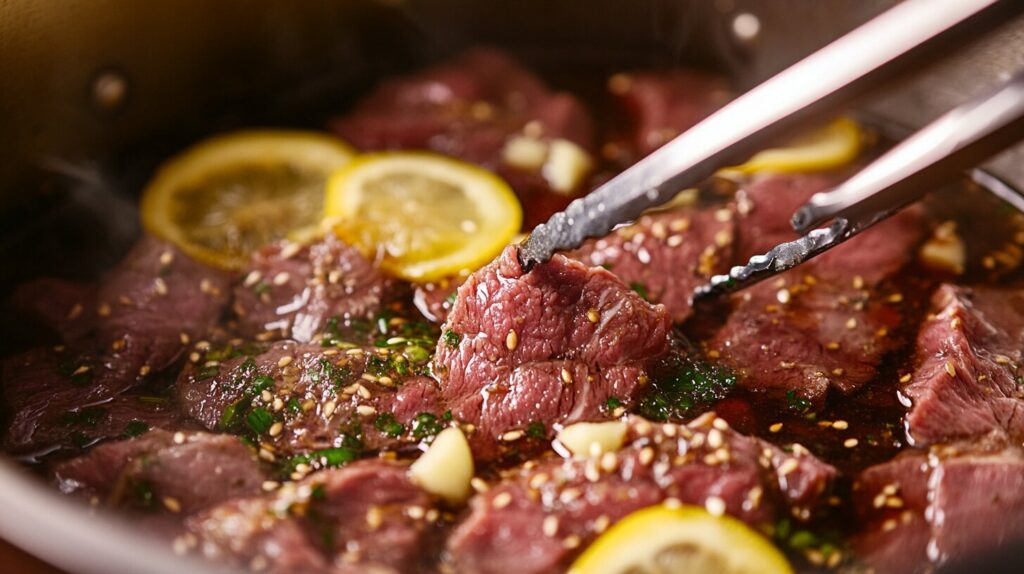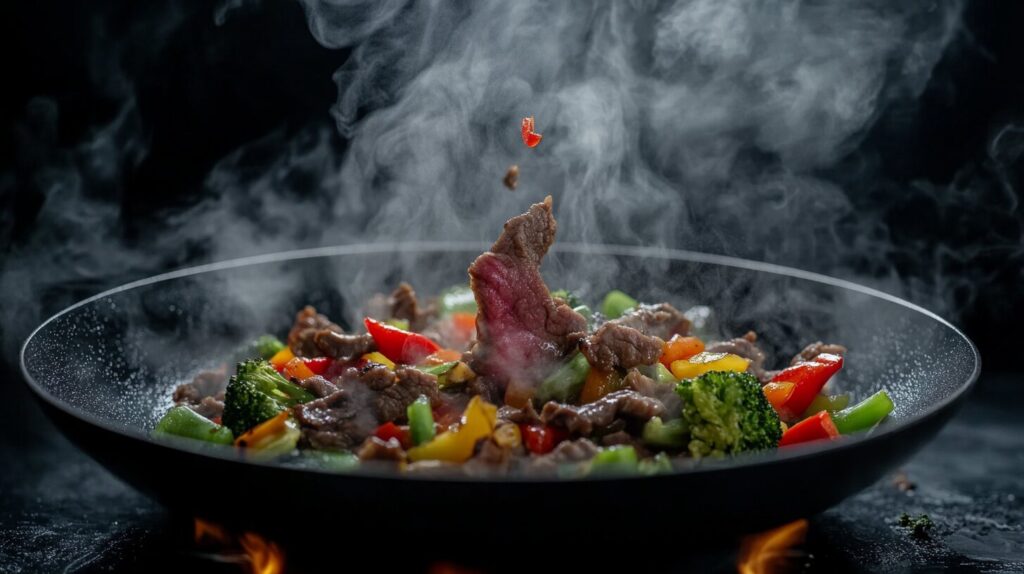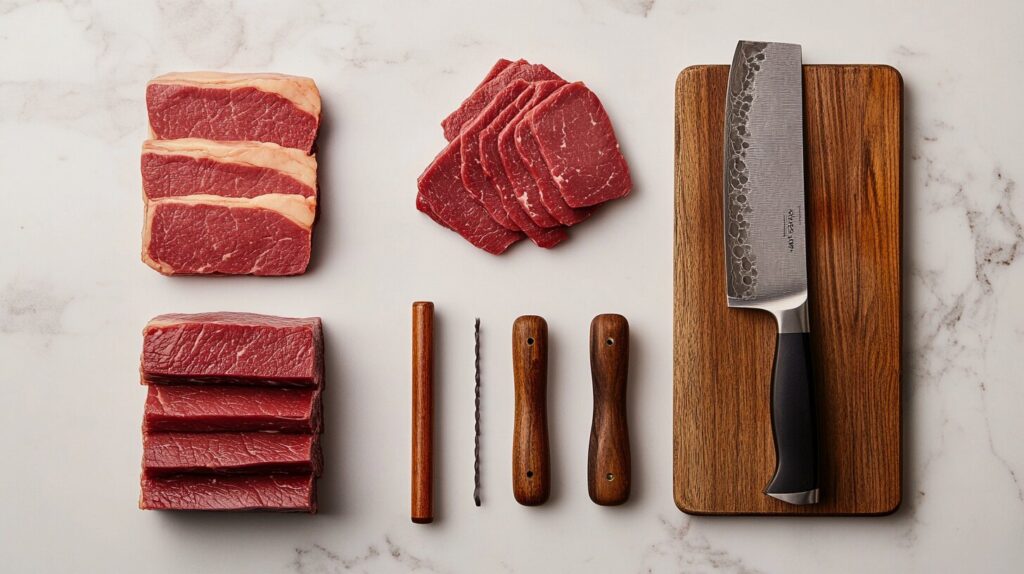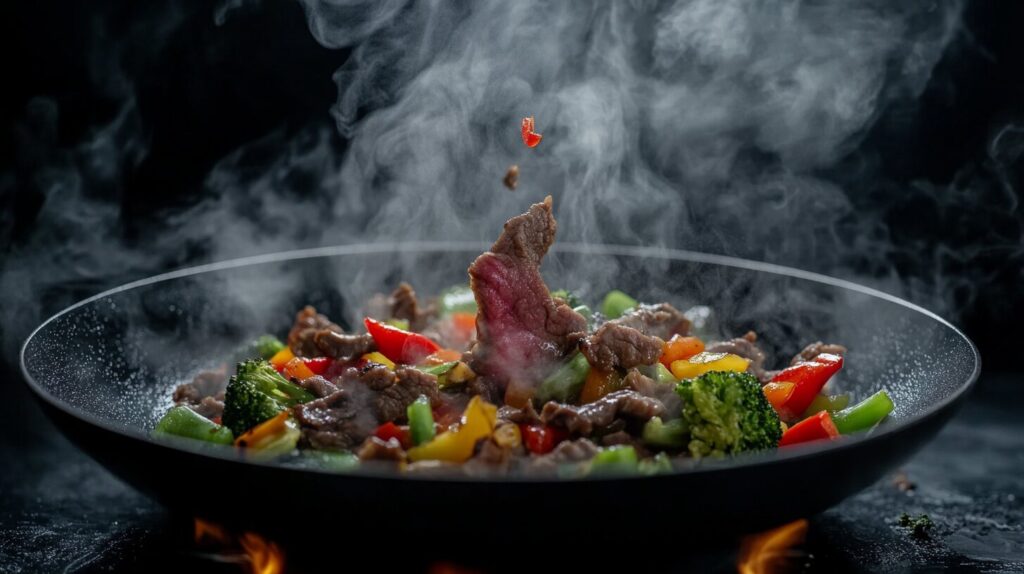
Thinly sliced beef can be a game-changer for your culinary adventures, but knowing how to make thinly sliced beef tender is key to avoiding tough, chewy results. When done right, tender slices add texture and flavor to everything from stir-fries and sandwiches to beef rolls and salads. If you’ve ever wondered why your stir-fry turned into a chewy mess or how your favorite restaurant gets their slices so tender, this guide is for you. We’ll cover everything you need to know, from choosing the right cuts and tools to mastering proven tenderizing techniques.
Let’s dive into the delicious world of tender, thinly sliced beef! 🥩
Table of Contents
Why Does Thinly Sliced Beef Need Special Tenderizing Techniques?
The Science Behind It
Thinly sliced beef is different from thick cuts because of the way muscle fibers interact with heat and moisture. When you cook thin slices of beef, they heat up rapidly — almost too rapidly. This quick heating causes the proteins in the meat to tighten, making them tougher. It’s a delicate balance between getting that seared flavor and avoiding the dreaded toughness.
Think of it like rubber bands. When you heat the rubber band slowly, it stretches and remains pliable. But if you snap it with heat quickly, it contracts and becomes rigid. Your beef slices are essentially edible rubber bands! Without proper techniques, they will seize up and toughen quickly.
The Challenge of Quick Cooking
Since thin slices cook within seconds, there’s little room for error. If you don’t take precautions to tenderize the beef beforehand, or you use the wrong cooking method, your beautifully sliced beef can turn into something that resembles shoe leather. Yikes!
That’s why tenderizing techniques like marinating, pounding, and choosing the right cut are crucial. These methods break down muscle fibers, ensuring the meat remains tender, even with rapid cooking.
Choosing the Right Cut of Beef for Thin Slicing

Best Cuts of Beef for Tender Thin Slices
Choosing the right cut of beef is half the battle. Some cuts are naturally more tender due to their muscle composition and fat content. Here are the best cuts for achieving tender, thin slices:
- Ribeye 🥩 – This cut is a winner for thin slicing because of its generous marbling (those lovely streaks of fat). The fat keeps the meat moist and tender when cooked quickly.
- Sirloin – A versatile and flavorful cut, sirloin provides a good balance between tenderness and beefy flavor. Perfect for quick stir-fries and grilling.
- Flank Steak – Flank steak might seem tough, but when sliced against the grain and tenderized properly, it delivers exceptional results.
- Tenderloin – The king of tenderness. If budget isn’t a concern, tenderloin (or filet mignon) slices beautifully and remains incredibly tender, no matter the cooking method.
Here’s a little tip: When in doubt, go for cuts that have a bit of fat marbling. The fat helps keep the meat juicy and flavorful!
“Fat is flavor, and when it comes to thin slices, a little marbling goes a long way.”
Cuts to Avoid for Thin Slicing
Some cuts are just not suited for quick, thin slicing unless you want to chew forever:
- Brisket – This cut is too tough unless it’s been slow-cooked for hours.
- Chuck Roast – While flavorful, chuck is filled with tough connective tissue. Not ideal for quick cooking.
- Round Cuts – Lean and mean, these cuts are better suited for stews or roasts. Thinly slicing them for a quick fry? Not a good idea unless you love jaw workouts.
If you’re stuck with one of these cuts, don’t worry! We’ll go over some tenderizing tricks later to help make even tough cuts more manageable.
Tools and Equipment You Need for Slicing Beef Thinly

Essential Kitchen Tools for Thin Slicing
Before you start slicing, make sure you have the right tools. The proper equipment will make your job so much easier (and safer!).
- A Sharp Chef’s Knife 🔪 – A high-quality, sharp knife is non-negotiable. Dull knives tear meat instead of slicing it cleanly, which can affect the texture.
- Meat Slicer – If you slice beef often, investing in a meat slicer can save you time and effort. Plus, it ensures consistent thickness.
- Cutting Board – A sturdy, non-slip cutting board is essential for safety and precision. Go for a board with grooves to catch juices and prevent slipping.
“A sharp knife isn’t just safer; it’s your best friend in the kitchen.”
How to Properly Sharpen Your Knife for Precision Cutting
A dull knife is a recipe for frustration (and potential accidents). Keeping your knife razor-sharp ensures clean, precise cuts.
- Use a Whetstone – Soak the whetstone in water for 10-15 minutes. Then, glide the knife blade across the stone at a 15-20 degree angle.
- Honing Rod – After sharpening, use a honing rod to maintain the edge. Hold the rod vertically and draw the blade down at the same angle you used on the stone.
- Test for Sharpness – Try slicing a piece of paper. A properly sharpened knife should glide through effortlessly. If it snags or tears, it’s back to the whetstone!
Keeping your knife sharp isn’t just about performance — it’s about safety. A sharp knife requires less force, reducing the chance of slipping and cutting yourself.
The Best Techniques to Tenderize Thinly Sliced Beef
Tenderizing thinly sliced beef is all about breaking down those stubborn muscle fibers. Here are some tried-and-true methods to ensure your beef stays melt-in-your-mouth tender.
Mechanical Tenderizing Methods
Sometimes, a little elbow grease is all you need! Here are a few mechanical methods that work wonders:
- Meat Mallet 🥩 – Place the beef slices between two sheets of plastic wrap or parchment paper. Gently pound them with the flat side of a meat mallet. This method breaks down the muscle fibers without turning the meat to mush.
- Scoring – For tougher cuts like flank steak, scoring the surface can help. Make shallow cuts against the grain to weaken the muscle structure.
- Needle Tenderizer – This nifty tool pierces the meat with tiny needles, allowing marinades to penetrate deeper and breaking down tough fibers.
“Think of mechanical tenderizing as giving your beef a mini massage — it loosens up those stubborn fibers!”
Marinating Techniques for Maximum Tenderness
Marinades are a game-changer for tenderizing thin slices. They not only add flavor but also work to soften the meat’s structure.
Tips for Successful Marinating:
- Use Acidic Ingredients 🍋 – Lemon juice, vinegar, or yogurt help break down muscle proteins.
- Add Flavor Boosters – Soy sauce, garlic, ginger, and herbs can turn a basic marinade into a flavor explosion.
- Don’t Overdo It – Thin slices only need 20-30 minutes to marinate. Any longer, and the acid can turn them mushy.
Using Acid-Based Marinades
Acids work their magic by breaking down proteins and making them more tender. Here are a few acid-based marinades to try:
- Lemon and Garlic Marinade 🍋 – Mix lemon juice, minced garlic, olive oil, and herbs. Perfect for Mediterranean dishes.
- Soy-Ginger Marinade – Combine soy sauce, ginger, garlic, and a splash of rice vinegar. Great for stir-fries.
- Yogurt Marinade – Yogurt, garlic, and cumin make a fantastic marinade for Indian or Middle Eastern dishes.
Step-by-Step Guide to Slicing and Tenderizing Beef Thinly
Perfectly tender, thinly sliced beef requires precision and preparation. In this section, we’ll walk you through the exact steps to slice your beef like a pro and tenderize it effectively. 🥩🔪
How to Slice Beef Thinly Like a Pro
If you’ve ever wondered how chefs get those beautifully thin and even slices, you’re in for a treat. Follow these simple steps, and you’ll be slicing like a pro in no time!
1. Chill the Meat First
Cold beef is much easier to slice thinly. Pop your beef into the freezer for 20-30 minutes until it firms up. You don’t want it frozen solid — just firm enough that it won’t squish under your knife.
2. Identify the Grain
Take a good look at your piece of beef. Notice the muscle fibers? Those lines are the grain. You always want to slice against the grain, which means cutting perpendicular to those lines. This shortens the muscle fibers, making the meat more tender.
3. Use a Sharp Knife
A dull knife can ruin your efforts by tearing the meat instead of slicing it cleanly. A sharp chef’s knife is your best friend here. Glide your knife through the meat with smooth, steady strokes.
4. Slice at a Consistent Thickness
Aim for slices about 1/8 inch thick. If you have a meat slicer, now’s the time to use it. If you’re using a knife, practice makes perfect! Keep your movements steady, and don’t rush.
“Precision slicing is like art. The more you practice, the better your slices will be!” 🎨
5. Use a Cutting Board with Good Grip
A stable cutting surface is essential for safety and accuracy. Make sure your cutting board doesn’t slip — place a damp cloth underneath it if needed.
6. Practice, Practice, Practice
Like any skill, slicing beef thinly takes practice. Don’t get discouraged if your first few slices aren’t perfect. You’ll get there! 💪
Best Practices for Tenderizing Post-Slicing
Once you’ve sliced your beef thinly, the tenderizing process isn’t over! Here are the best ways to ensure your thin slices stay tender:
1. Marinate Immediately
After slicing, get those pieces into a marinade right away. Thin slices absorb marinades quickly, and the acids or enzymes in the marinade will work their magic on those fibers. A quick 20-30 minute soak is often enough for thin slices.
2. Use a Meat Mallet Gently
If your beef is a bit tougher, give it a gentle pounding. Place the slices between plastic wrap and gently tap them with the flat side of a meat mallet. Be careful not to overdo it — you don’t want to turn your beef into mush.
3. Quick-Cook Methods Only
Thin slices are best cooked quickly. Methods like stir-frying, sautéing, or grilling over high heat for just a few minutes keep the beef tender. Overcooking is the quickest way to ruin all your hard work!
4. Avoid Excessive Handling
Try not to fiddle with the meat too much during cooking. The less you handle it, the juicier and more tender it will remain.
Common Problems When Tenderizing Thinly Sliced Beef
Even with the best intentions, things can sometimes go wrong. Here are some common pitfalls and how to fix them.
Why Does Your Beef Stay Tough Even After Tenderizing?
If your beef slices are still tough despite your best efforts, one of these issues might be to blame:
- Wrong Cut of Meat – Tough cuts like brisket or chuck require longer cooking times or advanced tenderizing methods. Stick to ribeye, sirloin, or flank for thin slicing.
- Slicing with the Grain – If you slice with the grain instead of against it, the fibers remain long and chewy.
- Overcooking – Thin slices cook incredibly quickly. If they’re on the heat for even a minute too long, they’ll toughen up.
- Inadequate Marinating Time – Give your marinade at least 20-30 minutes to work its magic. Less time means the meat won’t tenderize properly.
Over-Tenderizing: Signs and Solutions
Sometimes, you can go too far in your quest for tender beef. Here’s how to know if you’ve over-tenderized:
- Mushy Texture – If your beef feels mushy or falls apart, it’s been over-marinated or pounded too hard.
- Loss of Flavor – Over-tenderizing can dilute the beef’s natural flavor.
Solution:
- Reduce Marinating Time – For thin slices, 30 minutes is usually enough.
- Pound Gently – Use a light hand when tenderizing with a mallet.
- Adjust Your Acid Levels – Too much acid (like lemon juice or vinegar) can break down the meat too quickly. Balance your marinades with oil and herbs.
“Tenderizing is like seasoning. A little goes a long way — too much, and you lose what makes the meat special.”
Mistakes to Avoid When Preparing Thinly Sliced Beef
Thinly sliced beef can be unforgiving, but avoiding these common mistakes will help you achieve tender, delicious results every time.
Using the Wrong Temperature
Temperature plays a huge role in tenderizing and cooking beef. Here’s how to get it right:
- Cold Meat for Slicing – Partially freeze the meat for cleaner cuts.
- Room Temperature for Cooking – Let the meat come to room temperature before cooking to ensure even cooking.
- High Heat for Cooking – Quick, high heat (like in stir-frying) is perfect for thin slices.
Not Allowing Enough Marinating Time
Marinades need time to work their magic. For thin slices, 20-30 minutes is ideal. Rushing this step can leave your beef tough and flavorless.
Cooking Methods for Keeping Thinly Sliced Beef Tender
You’ve prepped, sliced, and tenderized — now it’s time to cook! Here are the best methods for keeping your thinly sliced beef juicy and tender.
Quick Stir-Frying for Tender Results

Stir-frying is one of the best ways to cook thinly sliced beef. The key is high heat and a quick cook time.
- Prep Everything Ahead – Stir-frying happens fast! Have your veggies, sauces, and beef ready to go.
- Use a Wok or Skillet – A hot wok ensures even cooking.
- Cook in Batches – Don’t overcrowd the pan. Cook the beef in small batches to keep the heat high.
- 2-3 Minutes Max – Thin slices cook in just 2-3 minutes. Any longer, and they’ll toughen up.
Gentle Simmering for Added Softness
If you’re making a saucy dish, simmering can help keep the beef tender.
- Brown the Meat First – Sear the slices quickly, then remove them.
- Simmer in Sauce – Add the beef back into the sauce at the end. Let it simmer gently for a minute or two.
- Don’t Overcook – Keep an eye on the clock. Thin slices need just a minute or two in the simmering liquid.
How to Store and Reheat Thinly Sliced Beef Without Losing Tenderness
You’ve sliced and cooked your beef perfectly, but what about leftovers? Proper storage and reheating can make the difference between tender, flavorful beef and something that resembles shoe leather. Let’s dive into the best practices for keeping your thinly sliced beef tender even after it’s been sitting in the fridge.
Best Storage Practices
1. Cool the Beef Properly Before Storing
Let the cooked beef cool to room temperature before putting it in the fridge. This prevents condensation, which can make the beef soggy or tough. But don’t leave it out for more than two hours — you don’t want to invite bacteria to the party!
2. Use Airtight Containers
Store your thinly sliced beef in an airtight container or a resealable plastic bag. This helps keep moisture in and air out, preventing the beef from drying out or absorbing unwanted fridge odors. 🥩🔒
3. Separate Layers with Parchment Paper
If you have multiple layers of thin slices, place a sheet of parchment paper between each layer. This prevents the slices from sticking together and makes reheating easier.
4. Refrigerate Promptly
Pop your container into the fridge within two hours of cooking. Proper refrigeration keeps your beef safe and tender. Use the beef within 3-4 days for the best quality.
5. Freezing for Long-Term Storage
If you need to store your beef for longer, freezing is the way to go. Here’s how:
- Place the slices in a freezer-safe, airtight container or a vacuum-sealed bag.
- Label it with the date — frozen beef is best used within 2-3 months.
- When ready to use, thaw it in the fridge overnight. Avoid thawing at room temperature to prevent bacterial growth.
“Think of your fridge and freezer as beef preservation superheroes. The quicker you store it, the longer it stays delicious!” 🦸♂️🥩
Reheating Methods That Maintain Texture
Reheating thinly sliced beef can be tricky. Do it wrong, and you’ll end up with dry, rubbery meat. Follow these methods to keep your beef tender and juicy.
1. Gentle Reheating on the Stovetop
This method is great for stir-fries or sautéed dishes.
- Low Heat, Short Time – Use a skillet over low to medium heat. Add a splash of broth, sauce, or water to prevent drying out.
- Cover the Pan – This helps trap steam and keeps the meat moist. Reheat for 1-2 minutes or until just warmed through.
2. Microwave with Caution
Microwaving can work if you’re careful. Here’s how:
- Use a Microwave-Safe Dish – Place the beef in a shallow dish.
- Add Moisture – A few drops of water, broth, or sauce help maintain tenderness.
- Cover Loosely – Use a microwave-safe cover to trap steam.
- Short Intervals – Reheat in 20-30 second bursts, stirring or flipping the beef between intervals to ensure even heating.
3. Reheating in Sauce or Broth
If your beef is meant to be served with a sauce, reheat it directly in the sauce. The liquid keeps the slices tender and adds flavor.
- Simmer Gently – Heat the sauce over low heat, then add the beef slices and let them warm up for 1-2 minutes.
4. Avoid the Oven
The oven is generally not ideal for reheating thin slices. The dry heat can quickly zap the moisture out of the beef, leaving it tough and unappetizing.
“Reheating beef is all about TLC — Tender, Low heat, and Controlled timing!” ⏲️❤️
Explore More Beef-Centric Culinary Adventures 🥩
If mastering thinly sliced beef got your taste buds tingling, there’s more to explore! Dive into our Ultimate Guide to the Perfect Beef Tips Recipe for delicious inspiration. Want to understand beef cuts better? Our guide on Understanding Beef Tips breaks it all down for you. And if you’re tackling tougher cuts, don’t miss Boiling Beef Tips Until Tender for tips on achieving melt-in-your-mouth results. With these resources, you’ll level up your beef dishes in no time! ✨
FAQs About Making Thinly Sliced Beef Tender
You’ve got questions, and we’ve got answers! Here are some of the most common queries about achieving perfectly tender, thinly sliced beef.
How Long Should You Marinate Thinly Sliced Beef?
For thin slices, marinating for 20-30 minutes is usually enough. Since the pieces are small, they absorb the marinade quickly. If you’re using a tougher cut, you can extend the marinating time to 1-2 hours — but be careful not to go beyond that, especially with acidic marinades, as the beef can become mushy.
Can You Use Baking Soda to Tenderize Beef?
Yes, baking soda is a fantastic tenderizer! It raises the pH level on the surface of the meat, which helps prevent the proteins from binding too tightly and becoming tough.
How to Use Baking Soda:
- Dissolve 1 teaspoon of baking soda in 1/2 cup of water.
- Toss the thin slices of beef in the solution and let them sit for 15 minutes.
- Rinse the beef thoroughly and pat it dry before cooking.
“Baking soda: the secret ingredient your beef didn’t know it needed!” 🧪🥩
What’s the Best Way to Slice Beef Against the Grain?
Identify the direction of the muscle fibers (the grain) in the meat. To slice against the grain:
- Position the meat so the grain runs horizontally.
- Use a sharp knife to slice perpendicular to the grain, cutting across the fibers.
- Aim for slices that are about 1/8 inch thick.
Slicing this way shortens the muscle fibers, making the beef easier to chew.
Can I Tenderize Beef Without a Mallet?
Absolutely! Here are some alternatives to using a meat mallet:
- Rolling Pin – Place the beef between plastic wrap and gently roll over it.
- Fork – Pierce the meat all over with a fork to break down the fibers.
- Hand Massage – Gently massage the beef with your fingers to loosen the fibers.
Does Freezing Beef Make It Easier to Slice Thinly?
Yes! Freezing the beef for 20-30 minutes firms it up, making it much easier to slice cleanly. Just don’t let it freeze solid — you want it firm, not rock-hard.
Conclusion: Mastering the Art of Tender, Thinly Sliced Beef
Congratulations! 🎉 You now have all the tools, tips, and techniques to create perfectly tender, thinly sliced beef every time. Whether you’re stir-frying, simmering, or grilling, you’ve learned how to:
- Choose the right cuts of beef.
- Use essential tools for precision slicing.
- Apply mechanical and marinade tenderizing methods.
- Avoid common pitfalls like overcooking or slicing with the grain.
- Store and reheat leftovers without sacrificing texture.
Tender, flavorful beef is within your grasp — no more chewy disappointments or tough bites! Now, go forth and slice with confidence. 🥩🔪
“Cooking is an adventure, and every slice of beef is a new chapter. Make it tender, make it delicious!” 😊✨
